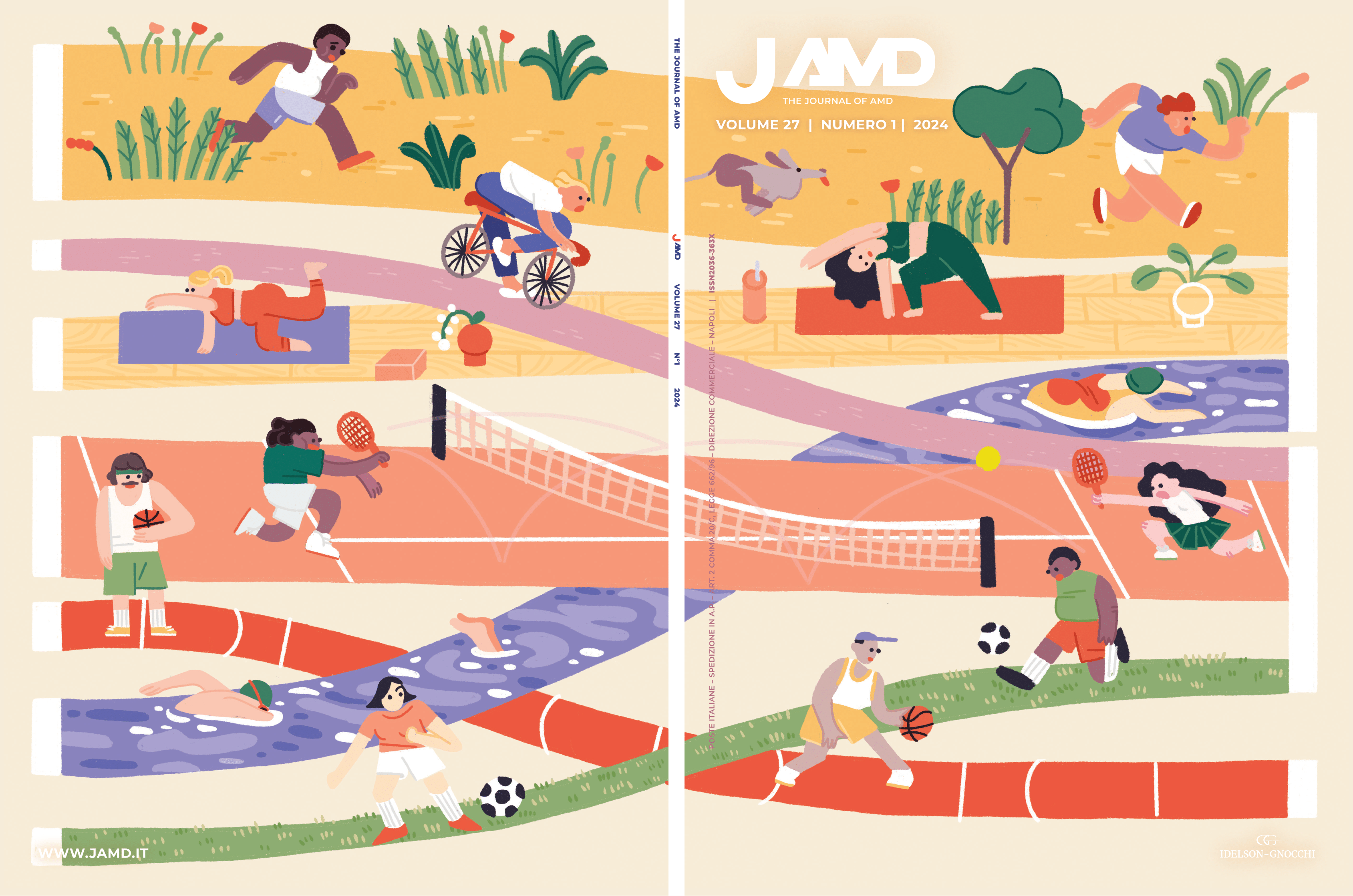Original articles
Management of insulin-dependent diabetes in low-resource countries: results from the chronic noncommunicable disease project in Iringa rural district of Tanzania
JAMD 2024;27(2):86-95
PURPOSE OF THE STUDY Chronic non-communicable diseases are experiencing a major growth in disease burden, especially in low-resource countries. Among them, diabetes represents a major challenge: its prevalence is growing exponentially in Africa, where scarcity of accessibility to care and resources make the issue even more burdensome. Insulin therapy in particular is very expensive and unwieldy. The aim of the study is to find answers to the emerging needs of people with diabetes in these settings
DESIGN AND METHODS A retrospective, prospective observational study of the diabetic population undergoing Premixed regular insulin/ NPH 30/70 insulin treatment was carried out as part of CUAMM’s chronic non-communicable diseases project in Tosamaganga Hospital in a rural area of Tanzania, a low- to middle-income country in sub-Saharan Africa. Data were extrapolated from the project database and from interviews with patients on active insulin treatment from March to August 2023.
RESULTS Improvement in blood glucose, glycated haemoglobin, and weight values over time; a reduction in the number of hospitalizations; a marked improvement in performance status; and a low rate of major hypoglycaemias were found. 83.1% of patients do not have health insuance, most have financial difficulties to support the cost of transportation to visit; counselling received on therapy and lifestyle is found to be very helpful and effective.
CONCLUSION Premixed regular insulin/NPH 30/70 insulin is effective and safe. Its low cost and increased manageability make its use desirable in low-resource countries due to issues of compliance and affordability. Increasing access to care and fostering qualified personnel is important to improve diabetes care in low-resource countries.
KEYWORDS low-resource countries; non-communicable disease; diabetes mellitus; insulin Premixed regular insulin/NPH 30/70.
Incretins in healthy and type 2 diabetic people
JAMD 2024;27(2):96-103
In the last decade analog drugs of incretin hormones receptors are increasingly used in the clinical management of individuals affected by metabolic disorders, as diabetes mellitus and obesity. In fact since the Leader study (the first randomized clinical trial demonstrating the cardiovascular effects of liraglutide) was published in New England Journal of Medicine in 2016, several data are nowadays available on benefits of single or double incretin analogs. However what is the specific role of the main incretins (glucagon-like peptide 1 [GLP-1] and glucose-dependent insulinotropic polypeptide [GIP]) in humans? After disclosing a brief tale of the of incretins in a previous paper, in this paper we showed the primary contribution of incretins in healthy subjects and in diabetic people, reporting the main evidences about the physiologic and pathophysiologic role of GIP and GLP-1, with a sperimental approach, rapresenting the basis for the subsequent development of drugs based on specific single and double analogs of incretin hormones.
KEY WORDS incretins; glucagon-like peptide 1 [GLP-1]; glucose-dependent insulinotropic polypeptide [GIP]; physiological role; glucose homeostasis.
Risk of foot ulceration in a population of patients attending a local diabetes care service
JAMD 2024;27(2):104-109
Diabetic foot syndrome is one of the most fearful complications of diabetic disease with a high rate of ulceration and amputation. Prevention, through screening and therapeutic patient education, is essential to reduce the risk of morbidity and mortality as well as financial burdens. Unfortunately, to date, data relating to screening are highly insufficient. This paper presents data relating to the screening of over 1000 patients performed in ASL TO5 as part of the Integrated Diabetic Foot Care Pathway. The screening was carried out by the diabetology nurses and in the districts by adequately trained local nurses and data were reported on the digital diabetology record (Metaclinic Meteda). The medium, high and very high ulcer risk was found in 17% of screened patients and is to be considered in line with international data (from 15 to 25%). The patients at risk were mainly men, over sixty-five, with a low level of education and often already had other disease complications. This work confirms the importance of screening as a fundamental test for the treatment and prevention of diabetic foot because, as widely documented, once the ulcer has been established, a vicious circle is entered which inevitably leads to unfavorable outcomes for the patient and healthcare costs high for society.
KEY WORDS: diabetic-related foot disease; type 2 diabetes; ulcerative risk; screening.
Integrated Clinical Pathway of diabetic retinopaty Screening in the North West Tuscany Local Health Authority
JAMD 2024;27(2):110-118
Diabetic retinopathy (DR) is the leading cause of blindness among working-age population in industrialized countries, including the Tuscany region, with very high social and health costs. DR screening is rapid, well tolerated by patients, and is considered one of the most cost-effective procedures known in medicine. Current scientific evidence has demonstrated that through screening and treatment programs for diabetic retinopathy, it is possible to drastically reduce blindness due to
diabetes.
In Italy, where such programs are only rarely applied across the territory, there are still many diabetic patients experiencing the most serious complications of retinopathy. Data from ARS Toscana relating to 2021 showed that in the North-West ASL only 11.15 % of patients with diabetes had their eyes checked at least once a year.
In order to define a shared protocol for the screening of diabetic retinopathy within our territory, i.e. that of the USL Toscana Nord Ovest (ATNO), we have established an integrated care pathway, which also has the aim to provide information about the indications, the method of execution, and the correct interpretation of the results from the evaluation of the ocular fundus using a non-mydriatic retinograph for the assessment and staging of diabetic retinopathy in patients with diabetes mellitus.
KEY WORDS: diabetes; screening; retinography; retinopathy; macular edema.
Narrative and theatrical medicine. Story of a difficult patient
JAMD 2024;27(2):119-124
The difficult patient is encountered both acutely and chronically and often his behaviors combined with those of the healthcare professional end up compromising the doctor-patient relationship.
In this article, which uses Theatrical and Narrative Medicine, we analyze situations in which we are faced when the interlocutor is “a difficult patient” and taking advantage of the scenic impact of narrative and theatrical communication, we tell true episodes in the life of a very famous character.
KEY WORDS: narrative based medicine (NBM); theatrical based medicine (TBM); M/P communication, difficult patient.
Reviews
Consumption of ultra-processed foods and noncommunicable diseases
JAMD 2024;27(2):125-135
Since ancient times, humans have developed techniques for processing and preserving food. With technological progress, these techniques have not only improved the preservation but also the nutritional quality and palatability of foods.
Ultra-processed foods (UPF) are products that have undergone a series of industrial transformations involving complex chemical and physical processes. These foods are ready to eat or heat and contain, among other things, ingredients not common in traditional cuisine, such as colourants, preservatives, flavor enhancers, sweeteners and other additives. UPF consumption is increasing and now constitutes a significant portion of dietary energy intake in high-income countries.
This article critically examines the scientific literature to clarify the relationship between UPF consumption and health. It also analyzes the underlying biological mechanisms and evaluates the long-term impact of these foods on human health.
The NOVA classification, used to identify UPFs, divides foods into four groups based on their degree of processing. Epidemiological studies link excessive consumption of UPF to obesity, cardiovascular disease and type 2 diabetes.
While studies are needed to improve the classification of UPFs, reducing their consumption and promoting a balanced diet rich in minimally processed foods could have a long-term positive impact on public health.
KEY WORDS: ultra-processed foods; food processing; NOVA classification; additives; type 2 diabetes mellitus.
Punto di vista
Basal insulin titration in gestational diabetes: which algorithm?
JAMD 2024;27(2):136-137





